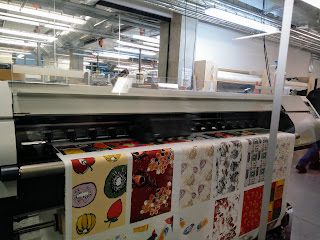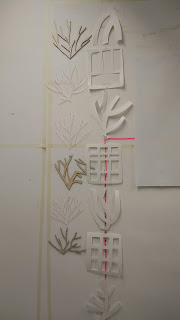Locating Unit Evaluation
In contrast to the geometric theme of the last project I
chose to focus on curves and movement for Locating, introducing a more
expressive element to my work. Drawing on A1 was daunting, but an exercise I enjoyed.
My drawings could be a lot freer, and I think they still have a sense of
constraint, but are more fluid than my usual sketchbook style.
I wanted to continue trying new techniques and combining
traditional and modern methods, a theme which has come to underpin my practice.
After identifying interior as my context, I researched wallpaper and paper
sculpting and began mark-making with pottery tools. I enjoyed creating
three-dimensional forms and see myself embracing a more mixed-media approach in
future projects. I found working with paper cutting and modelling a better way
for me to explore curves and movement than through the large-scale drawing, as
I could focus on the separate elements of shape rather than a whole drawing. I love
making things with a tactile quality, and although the paper maquettes are
ornamental, If I could take the project further I would like to make them in malleable
materials, to make them interactive.
Following this I had some of the shapes from my paper cut
forms laser cut. I moulded the laser cut pieces to take my designs from wall-based
artwork into more ornamental pieces. I have enjoyed seeing how I can take my
designs from one context to another and back again.
My digital wallpaper collection represents a more traditional
outcome which could be seen in an ordinary home setting. I would see my designs
as feature wallpaper. Working with half-drop repeats on photoshop presented a
challenge for me. In some of my designs there is a misalignment between the
motifs. If I had managed my time differently, I would allow more time to learn the
technique and resolve these issues.
To balance the digitally printed wallpaper I made a repeat
design screen but unfortunately, it did not quite align, so my samples ended up
looking miss-matched. I was disappointed with the results, but realise now that
because I cut through the motif, it was harder to match up the screen. When I
make a repeat in the future I will practice matching my repeats up on paper
thoroughly before making a screen.
I chose to do FFF as my live brief because I wanted to
challenge myself to learn new techniques like pattern cutting and 3D printing.
If I had the chance, I would love to try printing more ambitious 3D samples,
but time restrictions and access to facilities meant that in the end I chose to
develop a fabric based collar design. I kept my collar design simple so that I could
practice making it several times. I decided to keep the design the same and
experiment with different fabrics because I felt that this would be the best
way to include texture and curves by sublimation printing my designs onto
fabric.
Overall, I feel that I managed my time during Locating
reasonably well. I split my time roughly half and half between my
self-initiated project and the live brief but ended up with a larger output for
my own project. Working from the same body of research, my initial development
phase was easy to manage, but as the unit progressed I found it harder to
allocate equal time to each project and didn’t leave time to resolve unexpected
issues like my repeat screen. If I could do the projects again, I would assign
specific days to each project to avoid getting overwhelmed. I enjoyed doing the
two projects at once as I was constantly coming up with ideas and I never got
bored of either but I feel I have only scratched the surface of each project
which could have been resolved with more efficient division of time.


Comments
Post a Comment